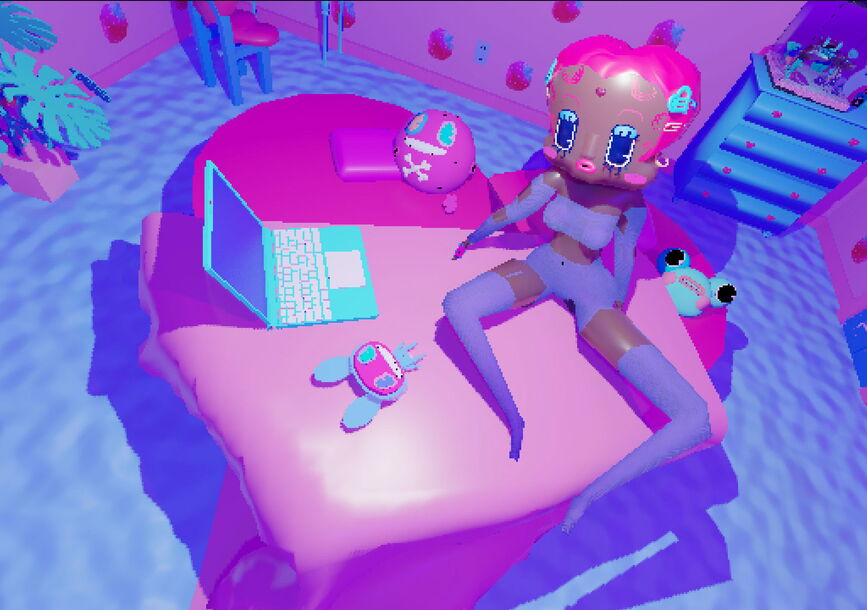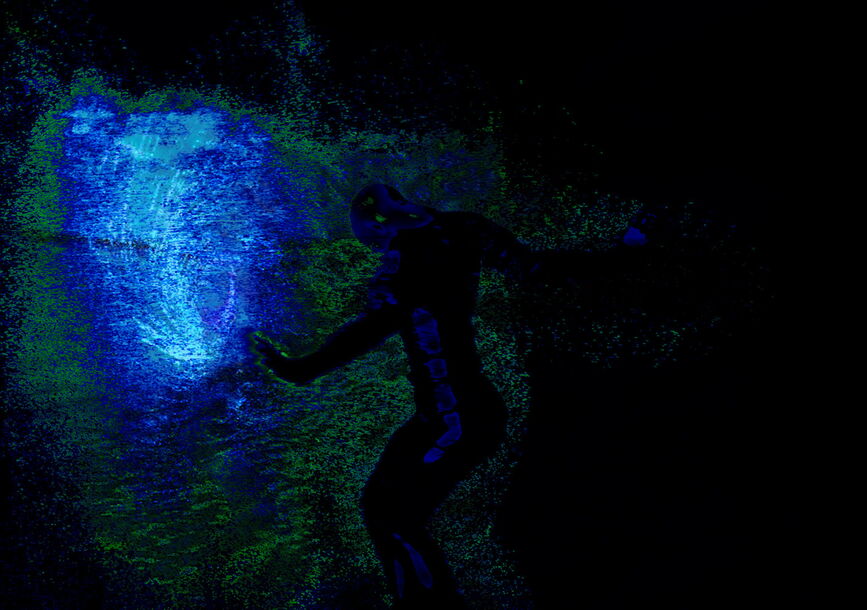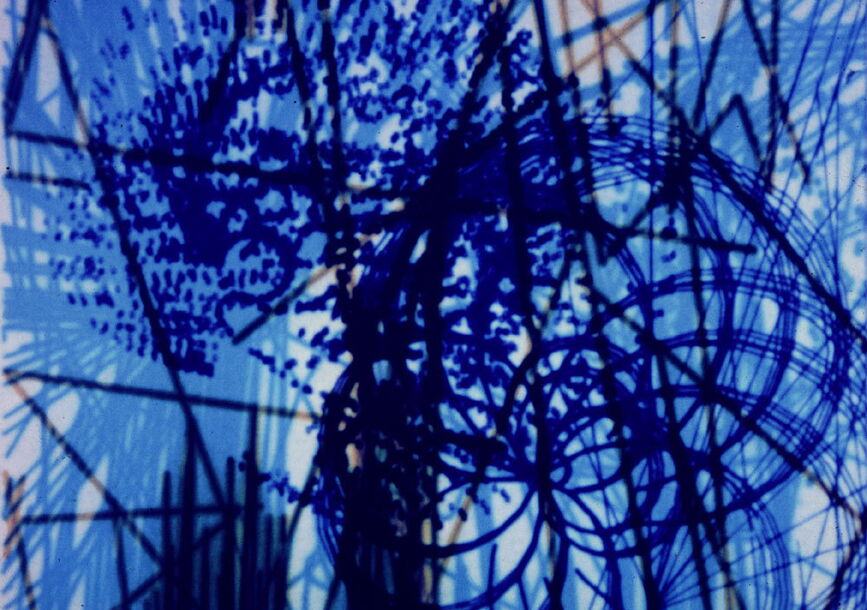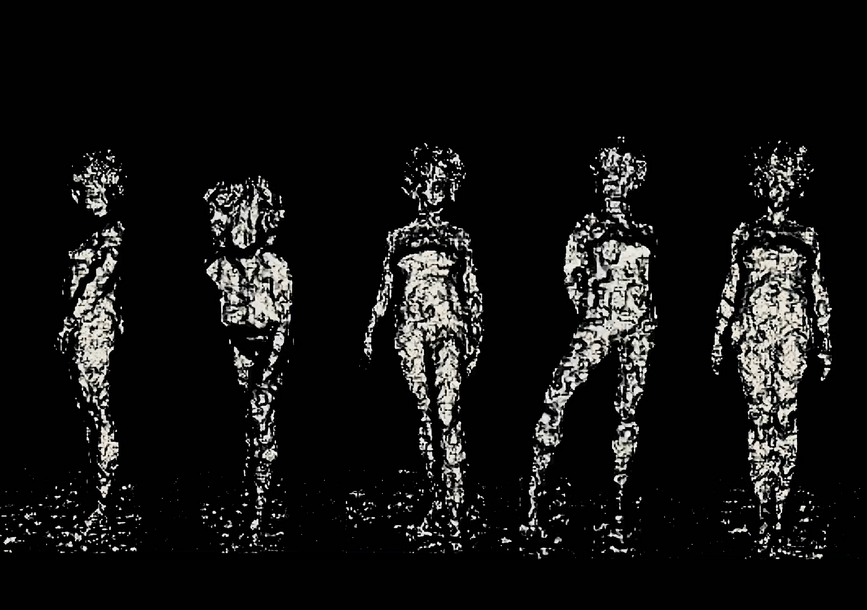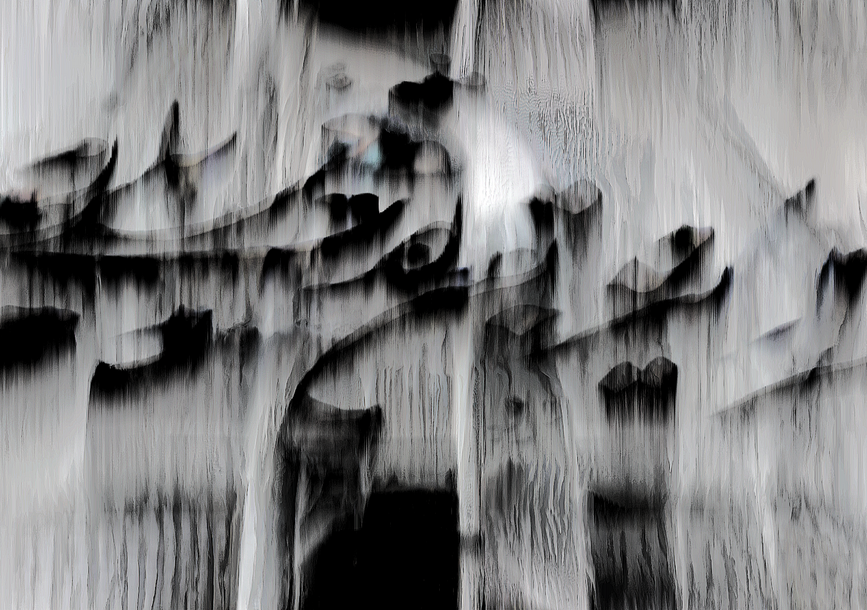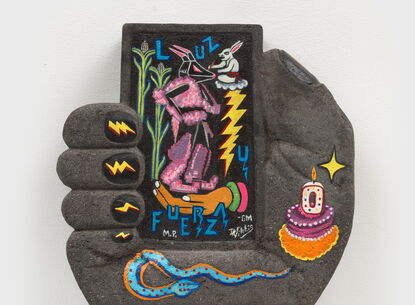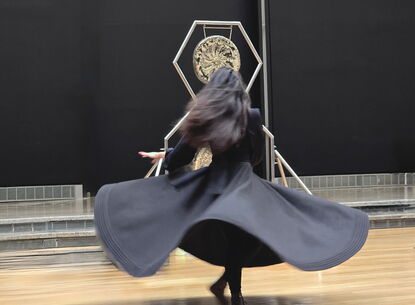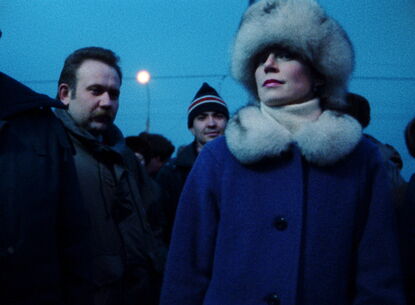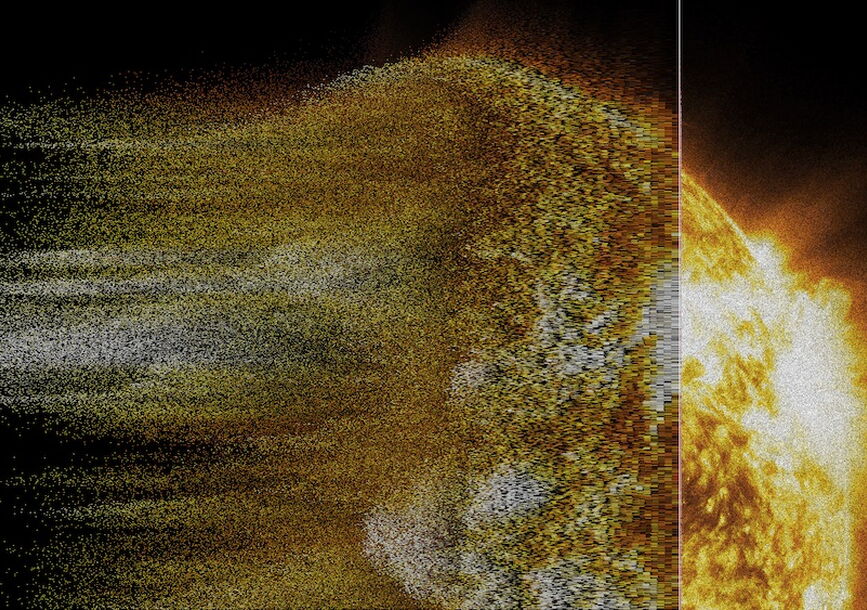
About the Artists
Natalie Paneng
Natalie Paneng is a New Media artist who is awkward, complex, has a quirk to her expression, and resides simultaneously in Johannesburg and the cyber village commonly known as the Internet. In 2018, Paneng completed a BA in Theater and the Performing Arts (Hons) from the University of the Witwatersrand, majoring in Production Design (Set and Costume Design) and Art Management. She now makes use of both her self-taught digital skills and her theater background to create multidisciplinary digital art.
Mary Ellen Bute
A pioneer of visual music and electronic art, Mary Ellen Bute produced over a dozen short abstract animations between the 1930s to the 1950s. Set to classical music by the likes of Bach, Saint-Saens or Shostakovich, and filled with colorful forms, elegant design and sprightly, dance-like-rhythms, Bute’s filmmaking is at once formally rigorous and energetically high-spirited, like a marriage of high modernism and Merrie Melodies. In the late 1940s, Lewis Jacobs observed that Bute’s films were “composed upon mathematical formulae depicting in ever-changing lights and shadows, growing lines and forms, deepening colors and tones, the tumbling, racing impressions evoked by the musical accompaniment.” Bute herself wrote that she sought to “bring to the eyes a combination of visual forms unfolding along with the thematic development and rhythmic cadences of music.” (Ed Halter)
John Stehura
John Stehura began studying computer programming at UCLA in 1961 when he was eighteen years old. He became quite conversant with computer languages and in 1965 programmed the first images that were to become the film Cybernetik 5.3 in its completed version some four years later. It is the only computer film Stehura has produced so far, having spent most of his time developing a special “metalanguage,” which he calls “Model Eight,” designed specifically for modeling computer music and graphics systems.
[Source: Gene Youngblood, EXPANDED CINEMA, 1970]
Ryoichi Kurokawa
Japanese artist, born in 1978, lives and works in Berlin, Germany. Ryoichi Kurokawa’s works take on multiple forms such as installation works, recordings, and concert pieces. He composes the time sculpture with the field recordings and the digital generated structures, and reconstructs architecturally the audiovisual phenomenon. In recent years, his works are shown across the world”at international festivals and museums including TATE Modern [UK], Centre Pompidou [FR], Venice Biennale [IT], Palais de Tokyo [FR], Barbican Centre [UK], ARS Electronica [AT], Mutek [CA/MX/JP/ES], Tretyakov Gallery [RU], Minsheng Art Museum [CN], YCAM [JP], EMPAC [US], LABoral [ES], FACT [UK], Palais des Beaux-Arts [BE], National Taiwan Museum of Fine Arts [TW], National Centre for Contemporary Arts [RU], CTM/Transmediale [DE], ACC [KR], Espace Culturel Louis Vuitton [FR] and Sonar [ES/UK/JP]. In 2010, he was awarded the Golden Nica at Prix Ars Electronica in the Digital Musics & Sound Art category.
Jeron Braxton
Jeron Braxton is a self-taught 3D animator using surreal Y2K gaming aesthetics to explore the American nightmare.
Nam June Paik
Korean-born artist Nam June Paik was a seminal figure in video art. His video sculptures, installations, performances and single-channel videos encompassed one of the most influential bodies of work in electronic media art. Merging global communications theories with an irreverent Fluxus sensibility, his work in music, performance and video explored the juncture of art, technology, and popular culture. Paik, who is recognized as a visionary artist of the international avant-garde, died in 2006.
Arash Akbari
Arash Akbari is a transdisciplinary artist, based in Tehran, Iran. His interest in dynamic art systems, human perception, nonlinear narrative, and the co-existence between physical and digital worlds compelled him to explore the fields of generative systems, interaction design, immersive technologies, and real-time processing. With a critical mindset toward the dominant paradigm of technology, he examines the counternarratives in which computational processes, interactive cybernetic systems, and their emergent behaviors can evoke concepts, ideas, and questions as well as social and emotional responses and impacts. Akbari directs his experimental practices into audio-visual performances and installations, interactive software, and multisensory experiences.
His music compositions investigate experimental approaches to sound generation, field recordings, acoustic instrumentation, digital synthesis, DSP, and noise to create immersive sonic environments that explore the agency of autonomous systems, audification, indeterminacy, memory, and the perception of time and space.
His work has been presented in different festivals and exhibitions around the world, such as DOK Neuland, Athens Digital Arts Festival, Geneva International Film Festival, ARS Electronica, Recto VRso Festival, Mutek Forum, Simultan Festival, Uncloud Festival, New Media Fest, 3D Web Fest, Cinnamon Colomboscope, Lacuna Festival, Videofenster, and Graphical Web Conference among numerous others. He has released albums on Farpoint Recordings, Karl Records, Flaming Pines, Unknown Tone Records, Taalem, and Soft Recordings.
Lillian F. Schwartz
Lillian F. Schwartz (B. 1927) began drawing as a child with a sidewalk canvas and brush of slate. In Japan during the occupation, she caught Polio. The treatment for overcoming paralysis consisted of learning to move her muscles until she could slowly draw with pen and ink. She never recovered from her stay near Hiroshima where shadow bodies that had been real people decorated remnants of buildings. Her early acrylics were often dark, bleak. She studied art techniques with well-know artists, but oils and acrylics were not enough. She moved them to plastic paintings over lights and to collages. Then kinetic fluid in lit boxes, electronic mobiles, plastic imagery through changing the chemical composition, and then a complex piece in MOMA that led to her entry into Bell Labs in 1968 where she developed programs, special color filters and editing techniques, art and historical analyses, art films and graphics that could be viewed in 2D or 3D without pixel shifting. A pioneer, she created a new technique for 2D/3D. In her 80s, she sees films in her mind filled by grand whorls of imagination with her memory of images she had created. From poverty and a cement canvas to paralysis cured through precise practice with pen and ink, from oils to kinetic metals to 2D/3D, she pushed and pushes through each media to find something more, something forever, changing vision, perception, and knowledge of life’s war and peace.
Arafa C. Hamadi
Arafa C. Hamadi is a multidisciplinary artist working in Tanzania and Kenya. They create both physical and digital work, aiming to create fully immersive spaces that explore their queerness in relation to space, focusing on joy and tangible ways of connecting their community.
Currently, they are developing their 3D/VR work titled “LETU 2.0” with the support of Electric South (SA), as well as developing a physical event in Dar-es-Salaam with Aichieli Temu. The space, ALTÆR, aims to be a model for events prioritising community, focusing on the safety of its marginalised attendees. Arafa is also part of the 2023 Building Beyond Mentorship programme by the Prince Claus Fund & Creative Industries Fund NL.
Ed Emshwiller
Ed Emshwiller is a major figure in the history of video art. As both an artist and a teacher, his pioneering efforts to develop an alternative technological language in video were enormously influential. He was an architect of the medium’s electronic vocabulary and one of its most accomplished practitioners. Emshwiller investigated the expressive capabilities of video synthesizers and computer systems while demonstrating an impulse to explore the humanistic potential and transformative properties of the medium, merging the technological with the personal and the symbolic. Through his work with emergent video technologies, articulated in such seminal tapes as Scape-mates (1972) and Sunstone (1979), Emshwiller introduced strategies that defined a new grammar of electronic image-making. —Electronic Arts Intermix
John Whitney Sr.
John Whitney Sr. (born in Altadena, California; 1917-1995) is considered a pioneer of computer graphics, visual music, and abstract film. He was an artist in residence at the California Institute of Technology (Caltech), a member of the art faculty at the University of California, Los Angeles (UCLA) and of the Academy of Motion Picture Arts and Sciences, which awarded him the Academy’s Medal of Commendation for Cinematic Pioneering in 1986. Whitney’s artistry in the visual medium as well as his ground-breaking filmmaking have also been recognized by the National Endowment for the Arts, the Guggenheim Foundation, and numerous other international institutions and festivals. Whitney is considered one of the first who has realized the dream of creating an art that looks like music sounds. Among his greatest achievements is the invention of a handmade mechanical apparatus that enabled him to choreograph abstract forms in a visual medium. In so doing, Whitney was able to render visible in his films the laws and fundamentals of music and discover complementary interactions between sound and image.
LaJuné McMillian
LaJuné McMillian is a new media artist, and Creative Technologist creating art that integrates performance, extended reality, and physical computing to question our current forms of communication. McMillian has shown and spoke about their work at Pioneer Works, National Sawdust, Leaders in Software and Art, Creative Tech Week, and Art && Code’s Weird Reality. The artist was previously the Director of Skating at Figure Skating in Harlem, where they integrated STEAM and Figure Skating to teach girls of color about movement and technology. They have continued their research on Blackness, Movement, and Technology during residencies at Eyebeam, Pioneer Works Barbarian Group, and Barnard College.
Films
SCREAMING INTO THE VOID.mp4 (2023)
Dir. Natalie Paneng, South Africa, 2 min.
Screaming Into The Void is an audio visual representation of inner feelings deeply linked and connected to unexplainable emotions and thoughts caused by digital exhaustion. The character finds herself in digital liminal space and investigates and intends to articulate these feelings and thoughts through statements and questions.
Screaming In the Void and A Nice Niceatopia are presented in contrast as an attempt to make links between how the digital both feeds and has the ability to offer rest and joy as well as be an extractive tool which leaves us depleted.
Abstronic (1952)
Dir. Mary Ellen Bute, USA, 6 min.
Bute was a pioneer of pre-digital electronic imagery, abstract animation and visual music. Born in Texas, she studied painting, stage lighting, and Thomas Wilfred’s lumia instruments, before turning to filmmaking. Working in New York, she directed a series of short abstract films she called “Seeing Sound,” many of which screened at Radio City Music Hall. Bute employed a variety of animation techniques and was one of the first filmmakers to use oscilloscope imagery in several films including Abstronic. Her producer/cinematographer partner Ted Nemeth produced flyers and press releases for her films: “These electronic pictures of the music are a natural phenomena which take place in the sub-atomic world; they are then captured on the Cathode Ray Oscilloscope and filmed with the motion picture camera. The colored backgrounds are hand done and superimposed on the electronic animation of the musical themes. In this movie, film artist Mary Ellen Bute combines Science an Art to create “Seeing Sound.” (C Keefer)
unfold.alt (2016)
Dir. Ryoichi Kurokawa, Germany/Japan, 4 min
With unfold.alt, a single screen version of unfold which was originally developed as an immersive installation, Ryoichi Kurokawa is concerned with the synaesthetic, merging audible and visual material inspired by recent astrophysical discoveries. These findings have been made by astrophysicists at CEA-IRFU, based on data produced by the satellites of the European Space Agency and NASA, and more specifically by the Herschel space telescope.
The work contains 10 phases presented in reverse chronological order of stellar formation. In the original installation version they are arranged in chronological order as: Interstellar medium, Molecular cloud, Massive star impact, Filament formation, Pre-stellar core, Protostar formation, Nuclear fusion and magnetic field, Supernova, Gravitational collapse, Neutronstar. unfold.alt seeks to translate the phenomena surrounding the formation of stars into sounds and images.
© 2016 RYOICHI KUROKAWA. All Rights Reserved.
ground.alt (2014)
Dir. Ryoichi Kurokawa, Germany/Japan, 1 min.
With ground.alt (reassembly of installation “ground”, 2011) Ryoichi Kurokawa provides a medium through which people can get an inside look at conflicts that feel foreign to their daily lives; and ground.alt leverages the medium to serve these images and sounds in a way that creates a rare intimate connection between the viewer and the distant worlds on the other side of the screen. The fragments of images and sounds make a rearrangement of time to avoid a story narrative. The long and slow sequence enhances the strain and pressure to the viewers. When we look at war photographs, we might try to see the story behind the scene or try to make a story based on the previous or next image. The war photography gives an impact on the eyes. The visual effect fascinates the viewers and stimulates directly to their perception
© 2011 RYOICHI KUROKAWA. All Rights Reserved.
Cibernetik 5.3 (1960-65)
Dir. John Stehura, USA, 8 min.
“The Cibernetik programs were developed between 1960 and 1964 in the basements of Santa Monica College and UCLA’s Boelter Hall on an IBM 7094, as personal research into movies and biologic systems. The original concept was to create an animation system that would allow anyone to create an animated movie as easily as writing a story. In the early 1960’s work on Cybernetik was encouraged by the efforts of Watson and Crick, and so the Cybernetic systems initially incorporated their own primitive genetic models to originate the forms and designate their related sounds using Bell Labs Music 4; along with a range of three-dimensional spatial environments where these forms could evolve, in fields of light, energy and gravity; all of which incidentally left far too many possibilities to even begin considering how to coordinate all the details. So a top-down AI learning system was implemented, which controlled the origination of both the environments and their visual organisms; based on personal opinions. The film result was the observation of their interactions.”—John Stehura
Oxytocin (2023)
Dir. Jeron Braxton, USA, 7 min.
Cash for organs and anything for love.
Digital Experiment at Bell Labs (1966-67 (circa))
Dir. Nam June Paik, USA/Korea, 4 min.
Using Bell Lab’s pioneering research facilities, Paik creates a starkly minimal experiment in computer imaging, in which a shifting dot appears on a black ground.
A. Michael Noll, a researcher and Professor Emeritus at the Annenberg School for Communication & Journalism at the University of Southern California, wrote of his experience working with Paik at Bell Labs, then one of the premiere research facilities in the world, in the late 1960s: “Paik visited me at Bell Labs…and I taught him the basics of computer programing using the FORTRAN language. This probably took a day or so, since Paik already had some knowledge of electronics and mathematics. I also created a small account for him, so that he could use the computer facility at Bell Labs, and he was off on his own.”
“[Digital Experiment at Bell Labs] shows a dot (a single pixel) that jumps randomly along a diagonal line. There is text that appears at the end, but that most likely is some sort of data dump from the computer and was not programmed by Paik. The word HEAD flashes at one point; the plotter would have created it to indicate the beginning of a movie strip of film.”
Transmutant (2023)
Dir. Arash Akbari, Iran, 5 min.
“The ta’wīl is essential symbolic understanding, the transmutation of everything visible into symbols, the intuition of an essence or person in an Image which partakes neither of universal logic nor of sense perception, and which is the only means of signifying what is to be signified” —Corbin, Henry. Creative Imagination in the Ṣūfism of Ibn ’Arabī. Routledge Library Editions 46. London: Routledge, 2008.
Two A.I. models have been trained on hand-picked datasets of Persian calligraphy and architecture. Both disciplines make use of symbolic forms and colors to perceive the correspondence between the hidden and the visible, and act as the passage to the invisible presence beyond the objective forms. The models generate variations of these forms while being completely detached from the metaphysical context behind them. Do these digital artifacts still have the quality that causes them to “symbolize with” another? The audio stream is composed using samples generated from a custom AI model that was trained on a corpus of Persian traditional music. —Arash Akbari
UFOs (1971)
Dir. Lillian Schwartz, USA, 3 min.
“UFOs proves that computer animation–once a rickety and gimmicky device–is now progressing to the state of an art. The complexity of design and movement, the speed and rhythm, the richness of form and motion, coupled with stroboscopic effects is unsettling. Even more ominously, while design and action are programmed by humans, the ‘result’ in any particular sequence is neither entirely predictable … being created at a rate faster and in concatenations more complex than eye and mind can follow or initiate.” —Amos Vogel, Village Voice
From the Collections of The Henry Ford. Gift of the Lillian F. Schwartz & Laurens R. Schwartz Collection
Lacework (2020)
Dir. Arafa Cynthia Hamadi, Tanzania, 23 sec.
“Lacework” is amongst multiple imaginings of the spatial quality of time during this seemingly endless period of the Covid-19 pandemic. The film is a synoptic narrative from the fictional perspective of Time. In it, I imagine several different events such as playing, self-observation and shame enacted over a period of time. These events are then laced together to create a single moment, alluding to the subjectivity of time.
These events were captured as solid digital forms using a 3D scanning application, which produced abstracted figures with abstract edges, which I believe are captures of motion. These figures - which I call echoes - were then placed within a single, boundless digital space amongst other scattered translucent echoes of their original environments. These echoes lace into each other creating a tapestry, which we view through the single, unmoving perspective. This perspective is perceived as that of Time because of the synoptic view of the events that unfold.
This layering and manipulation of the passage of time is echoed in the soundscape as well, which was recorded at each location the echoes were captured. In it we hear birds, ocean waves and echoing steps that overlap to create and unintelligible cacophony of sounds.
I, I, the Digital Self (2020)
Dir. Arafa Cynthia Hamadi, Tanzania, 3 min.
This short film is the visual representation of a poem I wrote in 2017 titled “I, I”. This poem was a reclamation of my body and autonomy, written while I was attempting to refit myself into a society that rejected my sexual and gender identity. The various figures that appear in the film are 3D scanned captures of myself, recreating several different moments of despair, doubt and self-harm that I continue to experience into the present, even as I develop through my new selves.
Sunstone (1979)
Dir. Ed Emshwiller, USA, 4 min.
Sunstone is a landmark tape. Symbolic and poetic, it is a pivotal work in the development of an electronic language to articulate three-dimensional space. The opening image is an iconic face, which appears to be electronically “carved” from stone. A mystical third eye, brilliantly crafted from a digital palette, radiates with vibrant transformations of color and texture. Sculpting electronically, Emshwiller then transforms perspectival representation: the archetypal “sunstone” is revealed to be one facet of an open, revolving cube, each side of which holds a simultaneously visible, moving video image.
Created with what was then complex technology over an eight-month period, this emblematic spinning cube metaphorically describes a three-dimensional, temporal space, both hyperreal and simulated. Emshwiller’s humanistic approach to technology ushered in the 1980s with a new electronic vocabulary for conceptualizing and visualizing images in space and time. Reflecting an image-saturated world, Sunstone marked a new stage in electronic art.
A NICE NICETOPIA (2022)
Dir. Natalie Pneng, South Africa, 3 min.
Niceatopia is a video work centred around Paneng’s personal detachment from social media, it is an expressive outlet for the artist to exist and play in another form of digital space. Using digital tools to replicate and recreate a simulated space where Paneng can exist and play as a Sim-like character whose existence then becomes more limitless. The video work aims to be a space of freedom, play and speculation for alternative realities
Arabesque (1975)
Dir. John Whitney, USA, 8 min.
In 1969–70, Whitney experimented with motion graphics computer programming at California Institute of Technology. By the 1970s, he had abandoned his analog computer in favor of faster, digital processes. He taught the first computer graphics class at UCLA in 1972. The pinnacle of his digital films is his 1975 work Arabesque, characterized by psychedelic, blooming color-forms.
Renaldo Black Movement Portrait
Dir. LaJuné McMillian, USA, 11 min.
The Black Movement Library is a library for activists, performers and artists to create diverse XR projects, a space to research how and why we move, and an archive of Black existence. BMP incorporates a narrative component to be seen as both live performance and video portraiture demonstrating how Black movement has been used as a tool for the preservation of Black culture and self-evolution. McMillain’s Movement Portraits serve as a way to dive into the lives of performers that contribute their movement data to BMP. This series ritualizes the archival process of data collection, inviting movement to be re-represented as a digital memory of life through motion.
About the Mover: Renaldo Maurice
Renaldo Maurice was a scholarship student at The Ailey School, has trained on scholarship at Ballet Chicago and Deeply Rooted Dance Theater, and had an internship at the Martha Graham School of Contemporary Dance. In 2008, he received second place in modern dance from the National Foundation for Advancement in the Arts and received the Dizzy Feet Foundation Scholarship in 2009. In February 2012, Renaldo was honored with the key to the city of Gary, Indiana, his hometown and also named a state representative. Renaldo has incorporated his passion for dance with the need for social responsibility by working as the Co-Artistic Director of the South Shore Dance Alliance back home in Indiana. Mr. Maurice is also the first USA black male brand ambassador of the What Dance Can Do Project based in Europe. He was a member of Ailey II for 3 years and has been a member of the Alvin Ailey American Dance Theater Company since 2011
